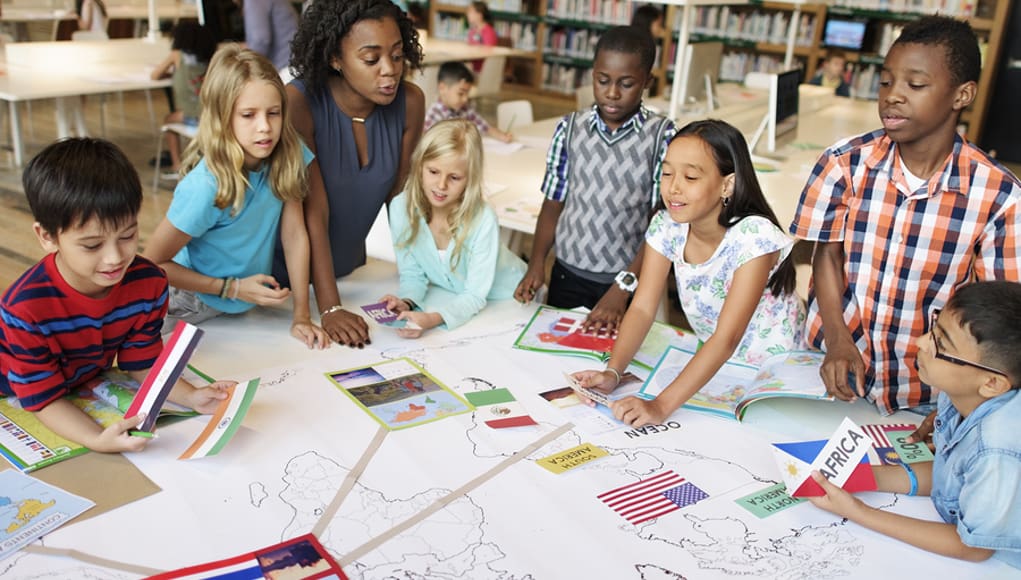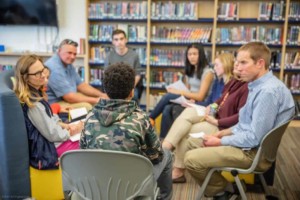6 Creative Classroom Project Ideas

By: Adam Welcome
I’ve heard it over and over again for the past ten years: “Our kids will have jobs that haven’t even been created yet.” But how do we get kids ready for jobs that haven’t yet been created? We overhaul the classroom projects we’re doing with kids to help reflect the world we live in and the jobs they’ll someday have.
No more dioramas.
No more mobiles.
No more incessant coloring.
No more trifold cardboard presentations for the science fair.
No more PowerPoint presentations.
It’s 2019. We have better options. And when you have better options, you need to do better! The classroom projects we have our students engaged with is a natural first step and a much easier transition than you may think.
1. Video Creation
There’s really no classroom project where you can’t incorporate some type of video creation. Before you think video creation isn’t right for your classroom, hold on just a minute. All you need is an iPad and some imagination. Then, let the kids go create! One of the coolest part of kids creating videos as a classroom project is that teachers don’t even need to know how to create the videos, the kids can handle that. Beyond that, creating videos solves a problem educators have experienced for many years—so many of the projects we’ve had our students engage in aren’t shareable outside the classroom! But the ability to share video projects across different platforms is supported across so many different sectors in 2019.
You can incorporate video creation into your classroom in just 4 steps.
- Take your classroom project idea.
- Brainstorm and mind map with your class all the different components that need to be included.
- Put them in groups to collaborate
- Give them an iPad with iMovie to create, edit, and produce what they’ve learned.
2. Experts
Bringing experts into your classroom across pretty much all disciplines allows your students to connect in fun ways that will take classroom projects to new levels. Just last year, I was speaking at a conference in Missouri and talking about how drones could be incorporated into the classroom. Two partner teachers in the crowd took the idea, went back to their school, and convinced their principal to purchase a few. They have no formal training in drones or how to operate them. But they do have passion, excitement, and the willingness to try something new (even if they fail). After just a few months of coding the drones in class, a local company that designs and builds drones actually heard about what they were doing. The company contacted the school to see if they could send their in-house experts to the class for support. WHAT!!! To say that the teachers and students were beyond excited is an understatement. Ask local experts for help. Or simply put out into the universe what you’re doing, and they may just contact you.
3. Robots
Robots are everywhere. They’re in hotels. They build the cars we drive. And some of them even drive the cars we drive. Incorporating robots into your classroom projects is a must in 2019. My favorite go-to robot is the Sphero. For $129, you can kickstart your classroom projects in pretty much any area of the content the day it arrives. Open the box, download the iPad app, and have kids create, design, problem-solve, and even work out math problems. A middle school class we worked with decided to incorporate their Sphero while learning about the Silk Road in Social Studies.
Instead of just reading about the Silk Road in a textbook and taking a quiz, they used the Sphero to code a map of it and learn that way! Check out the Sphero Academy for some awesome online professional development to get your classroom projects ramped up in no time!

4. Podcasts
Podcasting is the new blogging, and EVERY class needs a podcast. Five years ago, it was pretty labor intensive to record, upload, and distribute a podcast — not anymore! Podcasting is also a profession, so preparing kids for an actual job they may have someday is an excellent classroom project. There are tons of great resources and ways to get started with podcasting, and Anchor is my favorite one-stop-shop for it all. You can record and distribute it all in one place — for free!
Here are some ideas to get started with podcasting as a classroom project:
1. Book Reviews
Don’t just have kids talk about the book and what they enjoyed about each one. Have a book review podcast host who actually interviews students and creates dialogue about the books.
2. Sports Podcasts
If your students are excited about sports, try a Sports Talk Radio podcast. They can talk about their favorite teams, standout players, any stadiums they’ve been to, and maybe even some local Little League action can be thrown in for fun.
3. “Life As A …”
Kids can talk about their life at school, such as giving tips to younger grades, their favorite subjects, study habits, what to eat, and what to avoid in the lunchroom. It can be a reality show of sorts without all the cameras. Now that sounds fun!
Whatever your podcasting idea may be, it’s way too easy to start, and there’s absolutely no reason to not start today! Check out Anchor, and just start talking.
5. Create A Business
Creating a business as a classroom project is now more relevant than ever. I’ve seen this done in middle and high school over the years, and there’s no reason why it can’t be implemented in elementary as well. I say it’s relevant because pretty much anyone can start a business in 2019. You can build your own website for free, create an Instagram account and a Facebook page, and you’re ready to roll. You can have your students create an actual business, or a fictitious one, but still go through the website design and social media creation as an exercise.
Here’s a quick example: If I was in middle or high school right now, I’d take all the money from my savings and buy a nice camera and drone. Then, I’d go to the local real estate page and create an aerial video montage of every listing for sale in my hometown. You could try to sell the videos to all the realtors in town as part of their marketing package. Or — you could distribute them through your website and social media channels while tagging those realtors in your posts. Talk about guerrilla marketing and a great classroom project. It might even make your students some money while they’re in school.
6. Genius Hour
When in doubt, do Genius Hour. During my time as an elementary principal, we implemented a lot of innovative and new ideas. But the one that had the greatest impact across all grade levels and almost every subject matter was Genius Hour. It’s free. It’s super simple to get started. And if you’ve never heard of it before, just visit Edutopia and type Genius Hour in the search bar. You’ll have access to more videos, resources, and ideas than you can handle.
Final Advice
I have one piece of advice that will drop some serious educational mojo on your classroom projects. Here it is: Don’t overthink it. Way too often, adults complicate things by getting in their own way, second-guessing their own skills and maybe even lack of knowledge with something. The beauty of living in 2019 is that information and learning in general has been completely democratized. We have Google, Siri, and Alexa. And if you need some tech help — just ask a 9-year-old. Supercharge your classroom projects, and see what happens!
For more, see:
- 50 Resources for Makers and Creative Classrooms
- Fostering High Quality Student Experiences Through Projects
- Cultivating An Innovation Mindset in the Classroom
Adam Welcome has been an elementary school teacher, Principal, Director of Innovation for a large school district in the Bay Area and is also an author and speaker.
Stay in-the-know with innovations in learning by signing up for the weekly Smart Update.







0 Comments
Leave a Comment
Your email address will not be published. All fields are required.